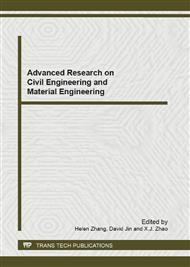p.200
p.204
p.208
p.212
p.216
p.222
p.226
p.230
p.234
Numerical Analysis of Shear Stress on Adhesive Joint between FRP and Steel Structure in Civil Engineering
Abstract:
Fiber reinforced polymer (FRP) is widely applied in the concrete and steel structure reinforcement field because of its high strength and convenient constructability in civil engineering. The adhesive joint is the weakness of the reinforced structure, but with the complicated stress distribution for analytic method. Numerical method provides the best solution to the further analysis. In this paper, a finite element method (FEM) of double lap joint model was established with ANSYS to investigate the shear stress in the adhesive joint of the reinforced structure, the shear stresses were analyzed in detail in both length and thickness direction in civil engineering. The results show that, 1) the FEM calculation results of shear stress of adhesive and the theoretical calculation values are consistent within the main part of the adhesive; 2) FEM is the effective method to further study the shear stress distribution of the adhesive, meshing size has great influence on the results of calculation; 3) to obtain more accurate analysis of shear stress distribution, the non-linear characteristics of the adhesive should be considered
Info:
Periodical:
Pages:
216-221
Citation:
Online since:
September 2012
Authors:
Price:
Сopyright:
© 2012 Trans Tech Publications Ltd. All Rights Reserved
Share:
Citation:


